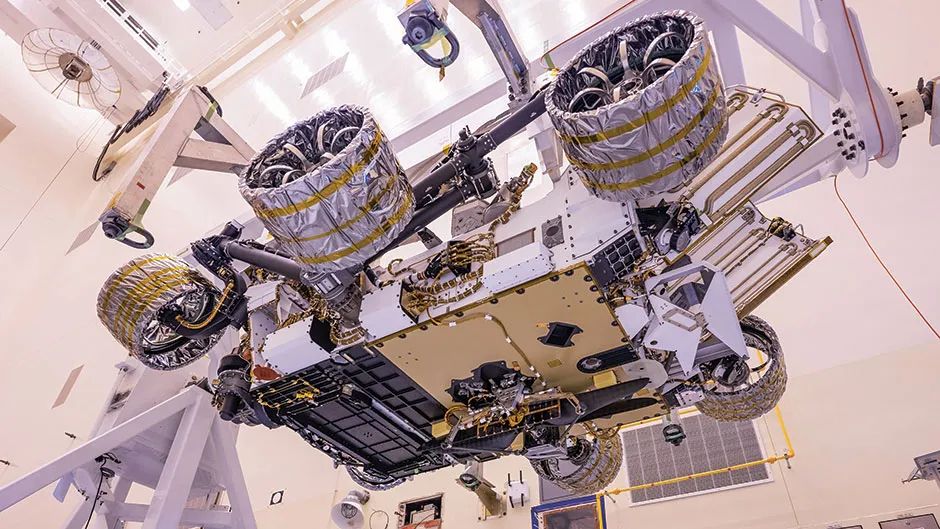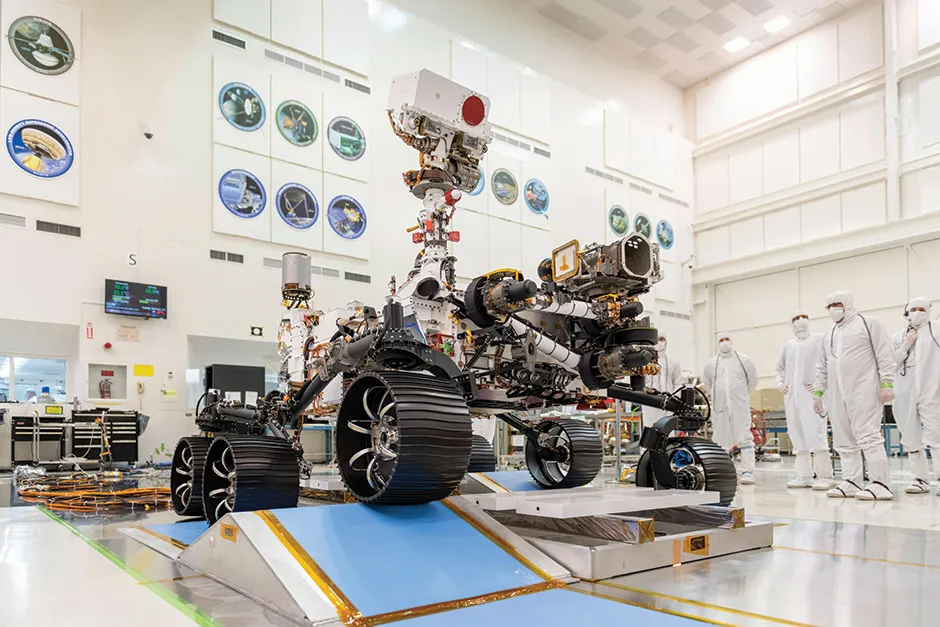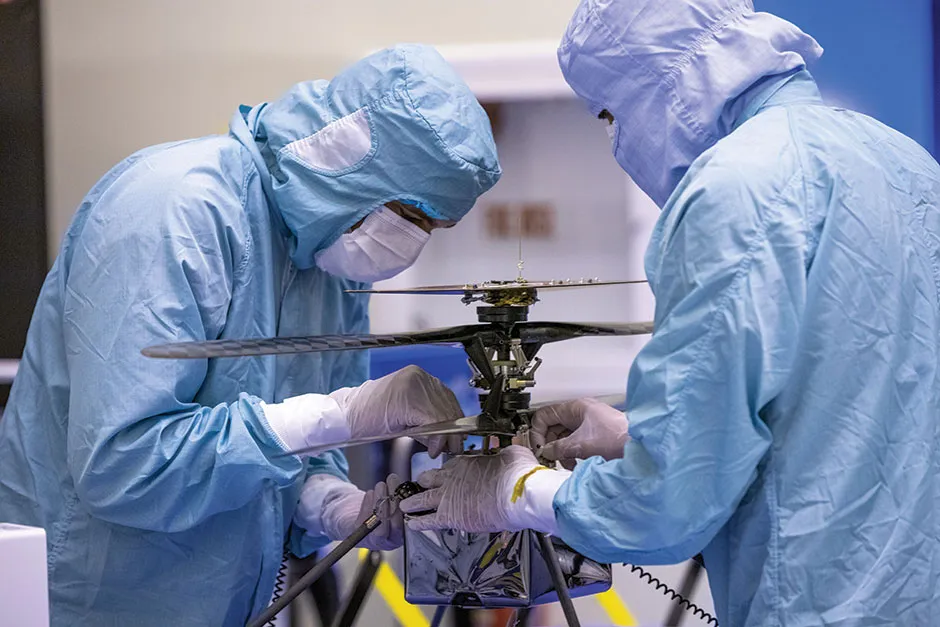Whether disrupting air traffic, returning glorious vistas of Earth from above, or just spying on the neighbours (if that’s your thing), drones have become a familiar sight in our skies. Now, for the first time, the US space agency NASA is poised to fly a drone-like helicopter in the atmosphere of another planet.
The craft, named Ingenuity, will hitch a ride to the Red Planet aboard the one-tonne Perseverance lander, NASA’s latest wheeled robotic rover mission to drive across the planet’s rugged surface. Perseverance is expected to launch from Earth this summer, with touchdown on Mars scheduled for Spring 2021.
Flying in the alien atmosphere of another world is a feat that poses a unique set of engineering challenges and yet, if this small technology test mission is successful, it will furnish scientists with a new and highly effective way to explore the planets and moons of our Solar System. That’s because flying is a much faster way to get around than ground roving.
Read more about NASA missions:
- The Voyager mission and our Pale Blue Dot: How the most famous picture in science came to be
- Race to Venus: What we'll discover on Earth's toxic twin
Aircraft can gather aerial imagery that’s much sharper than pictures returned by spacecraft. They can also serve as scouts to identify potential targets for ground-based rover vehicles, and they can even gather samples and bring them back to a central lander station for analysis.
And, of course, they can go where other probes simply can’t.
“Larger Mars rotorcraft in the 5kg to 20kg class with small science payloads could access areas not reachable by rovers, and support wide-area surveys in shorter times,” says Dr Bob Balaram, Ingenuity’s chief engineer, based at NASA’s Jet Propulsion Laboratory (JPL) in Pasadena, California.
“There is also a NASA mission to explore Saturn’s moon Titan with a flying lander that will arrive in the early 2030s.”

The Ingenuity craft is 50 centimetres high with four blades – one pair above the other – mounted on twin, counter-rotating rotors each spanning 1.2 metres.
The size of the rotors (which need to be this big for the helicopter to fly in Mars’s thin atmosphere) is the main reason why a more familiar drone-like quadcopter design was rejected – such a vehicle would be simply too large to fit on the rover.
Ingenuity is stowed beneath the body of Perseverance, from where it will be dropped onto the surface of Mars, probably a couple of months into the mission. The rover will then drive 100 metres away, to minimise collision risk, and the two will exchange radio signals to ‘pair up’ – a bit like pairing wireless earbuds to your phone – before the rover sends the command for Ingenuity to make its inaugural flight.
This will likely be what Balaram calls a ‘mutual selfie’ – the two vehicles taking pictures of one another as the helicopter rises to a low hover and then lands again.
How Ingenuity will explore Mars
Ingenuity carries a black-and-white navigation camera and a 4,208 x 3,120-pixel colour camera, comparable to what might be found in a mobile phone. Images are beamed by short-range radio link to Perseverance, which then relays them to one of a number of NASA spacecraft in Mars orbit, from where they are transmitted back to Earth.
“Multiple images may be stitched into a panorama at some point using ground software tools,” says Balaram.
The helicopter isn’t going to make any actual scientific observations, however. Instead, the focus is to return engineering data from the test flights that will, it’s hoped, validate the technology or at the very least provide valuable feedback to refine future designs.

The primary mission plan is for up to five flights over a period of 30 days, though this may be extended. The maximum horizontal range of the flights will be about 300 metres with a ceiling altitude of 10 metres and a max flight time of 90 seconds, after which the helicopter’s six lithium-ion batteries need recharging.
This is handled by a solar panel mounted directly above the rotor blades. A full charge takes a whole Martian day to complete, and two-thirds of the power stored is needed to keep the aircraft’s electronics warm during the bitterly cold Martian night, when temperatures can plunge to -100°C.
Specifications
- MASS: 1.8kg
- HEIGHT: 50cm
- ROTOR SPAN: 1.2m
- ROTOR SPEED: 2,300-2,900rpm
- MAX ALTITUDE: 10m
- BATTERIES: 6x Sony Li-ion, delivering 220W power
- MAX FLIGHT TIME: 90s
- RANGE PER FLIGHT: 300m
- MAX FLIGHTS PER DAY: 1
- MISSION DURATION: 30 days
The low temperature is only the beginning of the problems facing a would-be Martian aviator. Aircraft take off using ‘lift’, an upward force created as air passes over a curved aerofoil. On a plane, the aerofoil is the wing; on a helicopter, it’s the rotor blades.
But the surface density of Mars’s atmosphere is just 1 per cent of Earth’s. A cubic metre of air at sea level on Earth weighs 1.2kg, but on Mars that figure drops to just a few grams – roughly equivalent to the tenuous atmosphere on Earth at an altitude of 30,000 metres. And to generate enough lift to fly from such thin air means the engine has to work overtime.
Whereas helicopters on Earth typically spin their blades at 500 revolutions per minute (rpm), on Mars you need to crank this up to around 2,500rpm.
Read more about Mars:
- Wild ideas in science: We've already found life on Mars
- InSight: what NASA's mission to Mars could find inside the Red Planet
For the same reason, the weight of the craft is kept to an absolute bare minimum. For example, each pair of rotor blades weighs just 56 grams – despite measuring over a metre in length.
“Carbon composite layups within a foam core matrix were used to achieve lightweight but stiff blades,” says Balaram. In total, Ingenuity weighs in at just 1.8 kilograms, less than a couple of bags of sugar.
Balaram has even worked out the best time of day to fly the helicopter on Mars – mid-morning, as it turns out, roughly 11:00. By this time, the craft has been warmed by the Sun after the chilly Martian night, but the air is cool, keeping its density as high as possible and its wind speeds low, while the batteries still have a healthy charge.
“After we get the first couple of flights under our belt, I’m sure we will try to fly in the afternoon, and do more exploratory things, but the most conservative thing we can do is to pick a mid-morning flight,” he says.
Ingenuity on trial
The team tested their design inside the JPL’s Space Simulation Chamber, a 25-metre-high, eight-metre-wide cylindrical test vessel in which the atmosphere could be precisely tuned to replicate the aerodynamic conditions on Mars.
However, the low pressure was only one of the peculiarities of flying on Mars that had to be modelled. They still needed to account for the planet’s gravity, which is only 0.38 (just over a third) of that found on Earth. They came up with a novel solution.
“A gravity off-load device was installed into the chamber and was used to provide a compensating force on the vehicle to account for the difference in gravity between Earth and Mars,” says Balaram.

This literally means attaching a lightweight thread to the top of the vehicle, which they pulled tight just enough to lift 0.62 of the helicopter’s weight on Earth – leaving the remaining 0.38 (its weight on Mars) to be lifted aerodynamically by the rotors.
As well as demonstrating the basic feasibility of flight on Mars, these ground tests were crucial for another reason – allowing the team to fine-tune the Guidance, Navigation and Control (GNC) software that will actually have to pilot the helicopter on Mars.
When the first real Martian flights begin, the light-travel time from Earth to Mars will be many minutes, making it impossible for controllers to steer the craft remotely.
Instead, the commands from ground control on Earth consist of a set of waypoints – coordinates selected by controllers – which the GNC software will follow while taking account of the stream of real-time data flooding in from the helicopter’s sensors. These include gyroscopes, accelerometers, a navigation camera, an altimeter, and an inclinometer which measures the aircraft’s tilt.
Read more about space exploration:
- Move over, Mars: why we should look further afield for future human colonies
- Faster-than-light travel: Is warp drive really possible?
“Waypoints consist of an x-y position, a height above ground, a vehicle heading, and a desired time to arrive at each point,” Balaram says. To test the software, his team even set up multiple high-energy lamps inside the simulator to recreate sunlight illumination at the Martian surface, as well as fans to simulate flight in windy conditions.
On top of all this, Ingenuity must also be a spacecraft, certified to survive the stresses of launch, the seven-month journey to Mars during which it will be subjected to radiation and the harsh vacuum of interplanetary space, and then finally wracked by the high g-forces and scorching 2,200°C heat of entry, descent and landing through Mars’s atmosphere.
But if it works and the helicopter’s trials on Mars are a success, then it will be a genuinely historic achievement – the first-ever powered flight beyond Earth. And the expertise gained will lay the groundwork to fly bigger and better aircraft, capable of carrying a full payload of scientific instruments to explore the skies of distant worlds.
As Balaram puts it: “It’s kind of a Wright Brothers’ moment on another planet.”
- This article first appeared inissue 350ofBBC Science Focus